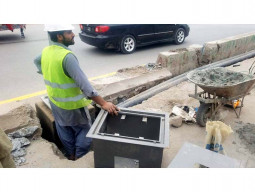
The BRT i.e. the Bus Rapid Transit appears to be a never-ending phenomenon. The government has repeatedly failed to fulfil its promise of completing the project on a given date, turning out to be a laughing stock before the public. The BRT’s inauguration was supposed to take place on March 23, but sensing the slow progress, Khyber-Pakhtunkhwa Chief Minister Mahmood Khan very realistically decided to cancel the opening ceremony. The project is now a good case study from the perspective of good governance. Of the known parameters of good governance, such as planning, efficiency, effectiveness, accountability, transparency, rule of law, internal economy, environmental protection and decision-making with outcomes and proper timelines, we can see none in the case of BRT.
The project was, unfortunately, launched in haste without proper feasibility. Essential principles and guidelines of planning and development were thrown to the wind and professionals with dissenting views were shown the door. Without adhering to the essentials of internal economy, cost-benefit ratio and internal rate of return, the project was launched at a whopping cost of Rs49 billion that soared to Rs68.7 billion. If the cost of land used is also included, then the cost is prohibitively high. Discarding the saner professional advices, the engineers were ordered to complete the construction within three months in order to outdo Mian Shehbaz Sharif’s pace of completing such projects. Consequently, engineering codes and guidelines of planning were flouted in order to achieve the impossible.
Sadly, the greenbelts all along Khyber Road, GT Road and Hayatabad have been destroyed in utter disregard for environment. With no pollution-control mechanism in place, citizens have been forced to wear masks. The superstructure acts as a barrier to the flowing water and the roads virtually turn into ponds during rains as there are no outlets. A project negatively affecting aesthetics is also a violation of environmental laws and contrary to the concept of sustainable development. The BRT has not only defaced the old city of Peshawar, but its concrete structure is also adversely affecting the aesthetics of the city by overshadowing the historical buildings and parks like Islamia College Peshawar, Jinnah Park (Cunningham Park) and Pir Bakhsh Building. The Environmental Protection Agency operates under the government and hence its reports on the project need to be verified independently.
Seen from the perspective of the needs of Peshawar, the project was conceptually wrong. The policymakers messed up the concept of an efficient public transport system. The BRT construction work has been a cause of regular traffic jams on the main arteries of Peshawar, GT Road, Khyber Road, Sunehri Masjid Road and Jamrud Road, with the policymakers failing to comprehend that the existing GT Road and University Road — having three lanes on each side — are wide enough to tackle the traffic flow. The completion of a ring road will take half the traffic load up to Karkhano-Hayatabad and upwards. London is an example wherein the roads are narrower than ours, but with better enforcement of law even double-deckers are ply there. To avoid the traffic congestion, the government has raised a new traffic warden system at a huge cost even though the need was for a better enforcement of traffic laws and optimum utilisation of the wardens. With further narrowing of the University Road, which is devoid of car parking spaces, the traffic mess is likely to multiply once the BRT starts operating.
Peshawar needed to have better buses and not such an extravagant concrete structure. In the past, double-decker buses of the Government Transport Service used to ply from Hashtnagri to the University of Peshawar on the same roads. In order to improve the flow of traffic, priority should have been given to an early completion of work on the Ring Road and Northern Bypass. Similarly, another parallel road from Cantonment Graveyard, near Warsak Road and Bihari Colony, towards Tehkal, Palosi and Regi might have also served to resolve the issue. These road projects had been approved by the previous government but are still gathering dust in official files. This way billions of rupees could have been saved and spent on more pressing problems.
Elevated roads are, generally, undertaken to solve the problem of the general traffic. The new megastructure being built is, however, meant only for few buses and not for the general traffic. If assessed on the basic principles of good governance, the BRT project is a poor reflection of public policy planning and management. Billions of bucks previously spent on the beautification of Peshawar have gone down the drain. This not only calls for a public apology, but also stresses the need for holding those accountable who are responsible for thrusting an ill-conceived project upon Peshawar.
Published in The Express Tribune, April 11th, 2019.
Like Opinion & Editorial on Facebook, follow @ETOpEd on Twitter to receive all updates on all our daily pieces.































1714129906-0/Clint-Eastwood-(1)1714129906-0-270x192.webp)






COMMENTS
Comments are moderated and generally will be posted if they are on-topic and not abusive.
For more information, please see our Comments FAQ